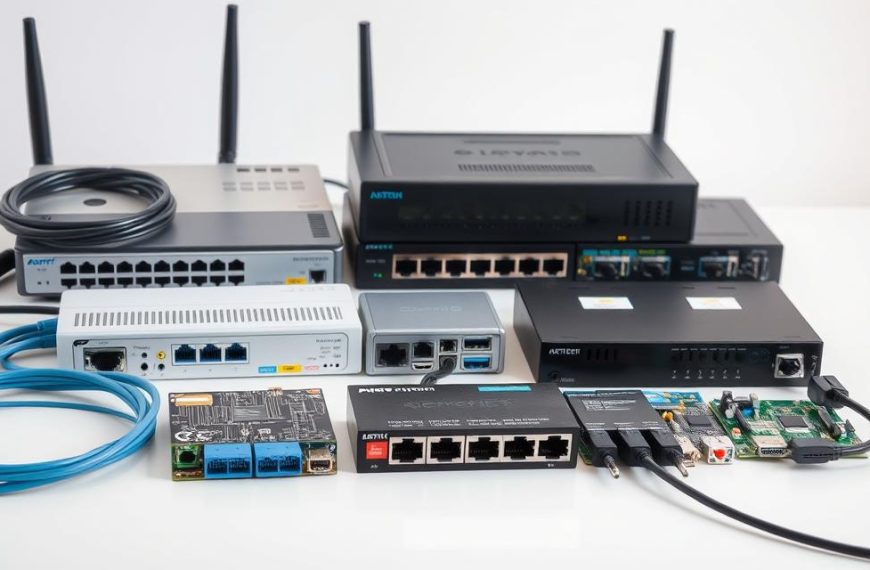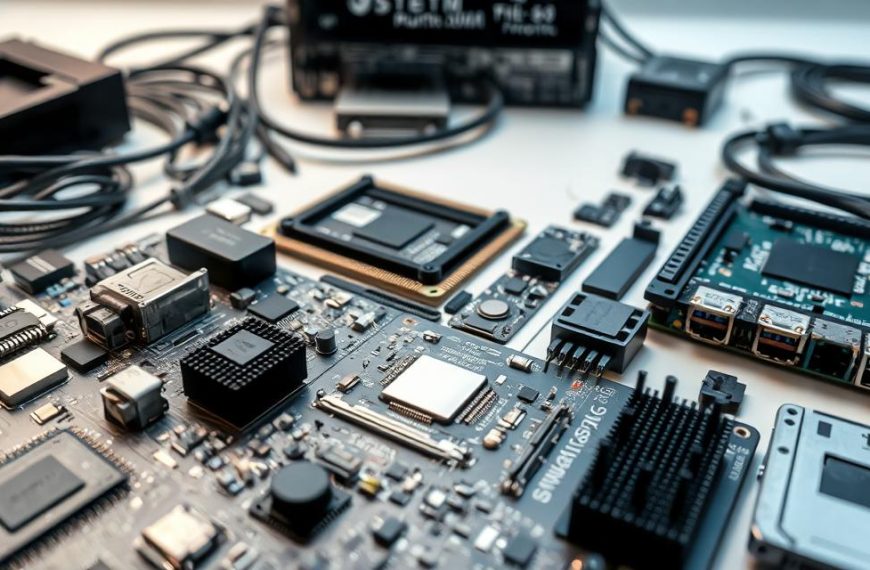The internet stands as the most extensive computer network globally, linking billions of devices. It operates through standardized protocols like TCP/IP, ensuring seamless communication across the world.
Originating from ARPANET in 1969, this network has evolved significantly. It now supports over 5.3 billion users, making it unparalleled in scale. Its infrastructure combines fiber optics, satellites, and wireless technologies for efficient data transmission.
Key milestones include the creation of TCP/IP in 1974 and the World Wide Web in 1989. These innovations laid the foundation for modern tools like email, cloud services, and real-time global communication.
Introduction to Computer Networks
At the heart of modern technology lies a system that connects devices seamlessly. This system, known as a computer network, links multiple devices to share resources and data. It’s the backbone of how we communicate, work, and access information today.
Defining a Computer Network
A computer network is a system that connects two or more devices using transmission media. These devices, called nodes, can include computers, printers, or servers. They communicate through links and follow specific protocols to ensure smooth data exchange.
Core components of a network include nodes, links, and protocols. Nodes are the devices, links are the connections, and protocols are the rules governing communication. This structure allows for efficient sharing of resources like printers, storage, and applications.
Importance of Networking in Modern Technology
Networking plays a critical role in today’s digital world. Businesses rely on computer networks for daily operations, with 73% of companies using LANs to stay connected. Networks enable cloud computing, IoT ecosystems, and enterprise resource planning, driving innovation and productivity.
From instant data access to distributed computing, networks have evolved from isolated systems to integrated digital ecosystems. They power essential services like email, file sharing, and real-time collaboration, making them indispensable in both personal and professional settings.
To learn more about the technical aspects of computer networks, explore this detailed resource.
What Is the Largest Computer Network?
Spanning continents and oceans, a vast digital ecosystem connects billions. This system, known as the internet, serves as the backbone of modern communication. It enables seamless data transmission across devices, making it the most extensive network in existence.
The Internet as the Largest Network
The internet links over 25 billion devices globally, from smartphones to servers. Its infrastructure includes 1.2 million kilometers of submarine cables, 3,000+ satellites, and 400+ Internet Exchange Points (IXPs). These components ensure rapid and reliable access to information worldwide.
With 98% of populated areas covered, even remote regions benefit from connectivity. Innovations like Starlink’s Low Earth Orbit (LEO) satellites expand this reach further. The world wide web, a key application of the internet, allows users to browse, share, and collaborate effortlessly.
Global Reach and Scale
The internet’s global scale is unmatched, handling 5 trillion gigabytes of traffic monthly. Developed regions experience latency under 50 milliseconds, ensuring smooth user experiences. Tier-1 ISPs like AT&T and Deutsche Telekom form the backbone of this massive network.
Technical advancements, such as IPv6 adoption reaching 40%, enhance its efficiency. Major data centers now support 400 Gbit/s Ethernet standards, boosting capacity. For a deeper dive into its workings, explore this detailed resource.
History of Computer Networks
Decades ago, the groundwork for today’s interconnected world began with simple yet groundbreaking innovations. Early developments in networking paved the way for the technology we rely on today. From the first transatlantic cable to the birth of the internet, each milestone shaped how we share data and communicate globally.
Early Developments in Networking
In 1956, the first transatlantic cable revolutionized communication, enabling faster data exchange across continents. Two years later, the Bell 101 modem introduced 110 bit/s transmission, marking a leap in network capabilities. These innovations laid the foundation for more advanced systems.
By 1958, the SAGE radar system demonstrated the potential of computers working together. This early example of distributed networking inspired future projects. The 1960s saw further progress, with ARPANET emerging as a pioneering force in technology.
The Birth of the Internet
In 1969, ARPANET sent its first message between UCLA and Stanford, marking the dawn of modern networking. This event showcased the potential of linking computers for seamless communication. By 1973, Ethernet’s invention transformed local area networks (LANs), enabling faster and more reliable connections.
The transition to TCP/IP protocols in 1983 standardized data exchange, ensuring compatibility across devices. Finally, in 1991, CERN released the World Wide Web to the public, unlocking a new era of global connectivity. These milestones highlight the time and effort invested in building today’s digital infrastructure.
| Year | Milestone | Impact |
|---|---|---|
| 1956 | First transatlantic cable | Enabled faster data exchange across continents |
| 1958 | Bell 101 modem | Introduced 110 bit/s transmission |
| 1969 | ARPANET’s first message | Marked the beginning of modern networking |
| 1973 | Ethernet invention | Revolutionized LANs |
| 1983 | TCP/IP standardization | Standardized data exchange protocols |
| 1991 | World Wide Web release | Unlocked global connectivity |
How Computer Networks Work
Behind every seamless connection lies a complex system of rules and technologies. These systems ensure data flows efficiently between devices, enabling communication and resource sharing. Understanding how they function is key to appreciating modern connectivity.
Basic Principles of Networking
Networks rely on structured models to manage transmission. The OSI model, with its seven layers, provides a comprehensive framework. Each layer handles specific tasks, from physical connections to application-level interactions.
In contrast, the TCP/IP model simplifies this into four layers. Both models ensure data moves smoothly across networks. Packet switching breaks information into smaller units for efficient transfer, while circuit switching establishes dedicated paths for continuous communication.
Communication Protocols
Protocols are the rules governing transmission. HTTP and HTTPS manage web traffic, while SMTP handles email delivery. VoIP protocols like SIP and RTP enable voice and video calls over networks.
Error handling ensures reliability. CRC checksums detect errors, and ACK/NACK responses confirm successful data delivery. Bandwidth management techniques, such as QoS, prioritize critical traffic like voice and video.
| Model | Layers | Function |
|---|---|---|
| OSI | 7 | Provides a detailed framework for network operations |
| TCP/IP | 4 | Simplifies network communication for practical use |
Types of Computer Networks
Modern connectivity relies on diverse systems tailored to specific needs. These systems, known as computer networks, vary in size, speed, and purpose. Understanding their differences helps optimize performance and efficiency.
Local Area Networks (LANs)
LANs connect devices within a limited area, such as an office or home. They typically cover distances of up to 1 kilometer and offer speeds exceeding 1 Gbit/s. Common topologies include star, bus, and ring configurations, with star being the most widely used.
Performance metrics for LANs are impressive, with latency often under 1 millisecond. Security measures like VLAN segmentation ensure safe data exchange. These features make LANs ideal for environments requiring fast and reliable connections.
Wide Area Networks (WANs)
WANs span large geographical areas, linking multiple LANs. They use leased lines like T1/E1 or advanced technologies such as MPLS for efficient data transmission. SD-WAN adoption is growing at 34% annually, reflecting its importance in modern networking.
Latency in WANs ranges from 50 to 200 milliseconds, making them suitable for less time-sensitive tasks. VPN tunneling enhances security, ensuring safe access across vast distances. These networks are essential for businesses with multiple locations.
Metropolitan Area Networks (MANs)
MANs cover cities or large campuses, bridging the gap between LANs and WANs. They employ dark fiber with DWDM technology, achieving capacities of up to 100 Gbit/s. A notable example is NYC’s NYCMesh, offering 300 Mbit/s free access to residents.
These networks balance speed and coverage, making them ideal for urban areas. Their scalability supports growing demands, ensuring seamless connections for users. MANs play a crucial role in enhancing regional connectivity.
- LAN Topologies: Star (most common), bus, ring configurations.
- WAN Technologies: SD-WAN adoption grows 34% annually.
- MAN Case Study: NYC’s NYCMesh provides 300 Mbit/s free access.
- Performance Metrics: Latency
- Security Considerations: VLAN segmentation vs VPN tunneling.
Key Components of a Network
Effective networking relies on essential components working together seamlessly. These elements ensure smooth data flow and efficient resource sharing. Understanding their roles is crucial for optimizing performance.
Nodes and Links
Nodes are the building blocks of any network. They include end devices like phones and PCs, as well as infrastructure such as routers and switches. Each node plays a vital role in transmitting and receiving data.
Links connect these nodes, enabling communication. Modern options range from Cat 8 cables to OM5 multimode fiber. Cat 6A cables, for example, support speeds of 10Gbit/s up to 100 meters, making them ideal for high-performance setups.
Servers and Clients
Servers form the backbone of network operations. Modern architectures include blade, rack-mounted, and hyperconverged systems. These devices use 100G NICs with RDMA for maximum efficiency.
Clients, on the other hand, rely on technologies like 802.11ax (Wi-Fi 6) for optimal wireless performance. Load balancing algorithms, such as round-robin and least connections, ensure even distribution of resources.
Redundancy measures like RAID configurations and failover clustering enhance reliability. These strategies minimize downtime and maintain seamless operations.
Network Topologies
Structured layouts define how devices interact within a system. These arrangements, known as network topologies, determine the efficiency and reliability of data flow. Choosing the right layout is crucial for optimizing performance and minimizing downtime.
Star, Bus, and Ring Topologies
The star topology connects all devices to a central hub. This setup reduces failure rates by 23% compared to bus networks. Each node operates independently, ensuring minimal disruption if one fails.
In a bus topology, devices share a single communication link. While cost-effective, this layout can suffer from bottlenecks. A single point of failure can disrupt the entire connection.
The ring topology links devices in a circular fashion. Data travels in one direction, ensuring efficient transmission. However, a break in the ring can halt the entire network.
Mesh and Hybrid Networks
Mesh networks provide multiple paths for data transmission. In a full mesh, each node connects to every other, offering n(n-1)/2 connections. This redundancy enhances reliability, making it ideal for IoT applications like Zigbee in smart homes.
Hybrid networks combine elements of different topologies. For example, a star-wired ring layout offers the benefits of both designs. 5G networks leverage dynamic mesh backhaul for seamless access and scalability.
- Military Applications: Self-healing MANETs ensure uninterrupted battlefield communication.
- Blockchain Networks: Decentralized P2P architectures enhance security and transparency.
- Cost Analysis: Mesh setups cost $15 per node, while star configurations are $8 per node.
Transmission Media in Networking
Transmission media form the backbone of modern connectivity, enabling seamless data exchange. These methods, both wired and wireless, ensure efficient network operations. Choosing the right medium is crucial for optimizing speed, reliability, and performance.
Wired Connections: Cables and Fiber Optics
Wired media remain a cornerstone of network infrastructure. Copper cables, like Cat 6A, support speeds up to 10Gbit/s but are limited to 100 meters. For longer distances, fiber optics excel, with single-mode fiber achieving 200Tbit/s through space-division multiplexing.
Comparing fiber types, OS2 offers lower attenuation rates than OM4, making it ideal for long-haul transmission. These advancements ensure high-capacity connections, even in demanding environments. Wired solutions are indispensable for stable and high-speed data transfer.
Wireless Connections: Radio Waves and Satellites
Wireless technologies have transformed how we access networks. Wi-Fi 7 (802.11be) enables speeds up to 40Gbit/s, leveraging the 6GHz band for enhanced performance. Emerging standards like Wi-Fi 6E further expand bandwidth, ensuring smoother connections in crowded areas.
Satellite systems, such as Starlink’s LEO constellation, deliver 150Mbit/s with latency as low as 20-40ms. In contrast, GEO satellites experience 600ms delays, making LEO ideal for real-time applications. Innovations like Li-Fi, achieving 224Gbit/s in labs, promise even faster wireless transmission in the future.
- Copper Limitations: 100m maximum for 10GBase-T.
- Fiber Types: OS2 vs OM4 attenuation rates.
- Wireless Standards: 6GHz band adoption in Wi-Fi 6E.
- Satellite Latency: GEO (600ms) vs LEO (20-40ms).
- Emerging Tech: Li-Fi achieves 224Gbit/s in lab conditions.
Network Protocols and Standards
Protocols and standards form the foundation of modern digital interactions. These guidelines ensure seamless communication and efficient data exchange across devices. Without them, the internet and other networks would struggle to function effectively.
TCP/IP and Its Role
The TCP/IP suite is the backbone of global networks. It includes over 500 protocols, each designed for specific tasks. TCP ensures reliable transmission, while IP handles addressing and routing. Together, they enable smooth communication between devices worldwide.
QUIC, part of HTTP/3, reduces latency by 30% compared to TCP. This makes it ideal for real-time applications. BGP, another critical protocol, routes over 600,000 IPv4 prefixes globally, ensuring efficient data delivery.
Other Essential Protocols
Beyond TCP/IP, several protocols play vital roles. For example, WireGuard outperforms IPsec in security benchmarks, making it a preferred choice for VPNs. In IoT, MQTT-SN and CoAP optimize energy consumption, extending device battery life.
IPv6 adoption is growing, with 35% of Google traffic now using it. This shift addresses the limitations of IPv4 and supports the expanding network ecosystem. Authentication protocols like RADIUS and TACACS+ ensure secure access in enterprise environments.
- TCP vs UDP: Reliability vs speed tradeoffs.
- IPv6 Adoption: 35% of Google traffic uses IPv6 (2023).
- Security Protocols: WireGuard vs IPsec performance benchmarks.
- IoT Protocols: MQTT-SN vs CoAP energy consumption.
- Authentication: RADIUS vs TACACS+ for enterprise networks.
Applications of Computer Networks
From browsing the web to instant messaging, computer networks power countless daily activities. These applications have transformed how we communicate, work, and access information. Whether it’s streaming videos or sending emails, networks make it all possible.
World Wide Web and Browsing
The web is one of the most widely used applications of computer networks. Over 68% of web traffic now comes from mobile devices, highlighting its accessibility. Content delivery services like Akamai handle 325Tbit/s of data, ensuring fast and reliable browsing experiences.
Streaming protocols such as SRT and WebRTC optimize packet loss recovery, enhancing video quality. RESTful APIs drive 83% of web traffic, enabling seamless interactions between services. These innovations make the internet a cornerstone of modern life.
Email and Instant Messaging
Email remains a vital communication tool, handling 333 billion messages daily. Instant messaging platforms like Discord support 150 million monthly active users with voice latency under 50ms. These applications rely on robust networks to deliver real-time data.
Cloud gaming platforms, such as NVIDIA GeForce Now, use 256-bit AES encryption to secure data during transmission. WebRTC facilitates over 1 billion video calls daily, showcasing the versatility of modern networks. These technologies continue to redefine how we connect and collaborate.
Impact of Networks on Society
Modern society thrives on interconnected systems that drive progress. These systems, built on robust networks, have reshaped how we live, work, and interact. From enabling instant communication to fostering economic growth, their influence is undeniable.
Communication and Collaboration
Networks have revolutionized how we connect. Tools like email and instant messaging handle billions of messages daily, ensuring seamless communication. Platforms like Zoom and Microsoft Teams support remote collaboration, bridging gaps across the world.
Telemedicine is another breakthrough, with 76% of US hospitals using telehealth services. This innovation ensures patients receive care without geographical barriers. Similarly, IoT-enabled smart cities, like Barcelona, save €75M annually by optimizing resource management.
Economic and Educational Benefits
Broadband access boosts GDP by 1.38% annually, driving economic growth. Remote work alone saves $758B yearly in US productivity. E-commerce, valued at $6.3 trillion in 2023, thrives on reliable networks, offering businesses global reach.
Education has also transformed. MOOCs reach 220 million learners globally, while 92% of universities offer online degrees. These advancements ensure equitable access to knowledge, bridging the digital divide.
| Area | Impact |
|---|---|
| Healthcare | 76% of US hospitals use telehealth networks |
| Economy | Broadband access boosts GDP by 1.38% annually |
| Education | MOOCs reach 220 million learners globally |
| E-commerce | $6.3 trillion in 2023 online sales |
- Digital Divide: 37% of the world population remains offline.
- Smart Cities: Barcelona’s IoT network saves €75M annually.
- Remote Work: Saves $758B/year in US productivity.
Security in Computer Networks
Ensuring robust protection for digital systems has become a top priority in today’s interconnected world. With cybercrime costs reaching $8 trillion annually, safeguarding networks is essential. From malware to unauthorized access, threats are evolving rapidly, demanding advanced solutions.
Common Threats and Vulnerabilities
The threat landscape is more complex than ever. Over 560,000 new malware variants emerge daily, targeting vulnerabilities in software and hardware. Phishing attacks, ransomware, and DDoS assaults are among the most prevalent risks. These threats exploit weak protocols and human error, causing significant damage.
Zero-day vulnerabilities, unpatched systems, and misconfigured firewalls are common entry points for attackers. Organizations must stay vigilant, as even a single breach can compromise sensitive data. Proactive measures are crucial to mitigate these risks effectively.
Measures to Protect Networks
Adopting a multi-layered approach is key to enhancing security. Multi-factor authentication (MFA) blocks 99.9% of automated attacks, adding an extra layer of defense. Encryption standards like AES-256 and ChaCha20 ensure data remains secure during transmission.
Network segmentation, particularly microsegmentation, reduces breach impact by 94%. AI-driven tools like Darktrace’s Antigena can stop ransomware in just 1.7 seconds. Compliance with frameworks like NIST CSF 2.0 ensures adherence to best practices, minimizing vulnerabilities.
| Measure | Benefit |
|---|---|
| Multi-Factor Authentication | Blocks 99.9% of automated attacks |
| Encryption (AES-256) | Secures data during transmission |
| Microsegmentation | Reduces breach impact by 94% |
| AI Defense (Darktrace) | Stops ransomware in 1.7 seconds |
| NIST CSF 2.0 Compliance | Ensures adherence to security best practices |
- Threat Landscape: 560,000 new malware variants daily.
- Encryption Standards: AES-256 vs ChaCha20 performance.
- AI Defense: Darktrace’s Antigena stops ransomware in 1.7s.
- Compliance: NIST CSF 2.0 framework requirements.
Future of Computer Networks
Advancements in digital connectivity are reshaping the landscape of global communication. Emerging technologies and evolving trends are driving the next generation of networks, promising faster speeds, enhanced security, and smarter operations.
Emerging Technologies
6G is set to revolutionize connectivity, targeting speeds of 1Tbit/s by 2030. This next-gen technology will enable real-time applications like holographic communication and advanced IoT ecosystems. Quantum networking is another breakthrough, achieving 1,200km quantum key distribution for ultra-secure data transmission.
AI-driven networks are reducing operational expenses by 40%. These systems optimize traffic, predict failures, and automate maintenance, ensuring seamless performance. Innovations like these are laying the foundation for a more connected and efficient future.
Trends in Networking
Hyperscale data centers are adopting 800G Ethernet to handle increasing data demands. Network slicing for 5G standalone (SA) networks is enabling customized services for industries like healthcare and manufacturing. By 2025, 75% of data will be processed outside traditional clouds, thanks to edge computing.
Post-quantum cryptography is gaining traction, with NIST PQC standardizing protocols to counter quantum threats. Intent-based networking is also on the rise, with 35% of enterprises adopting it to simplify network management. These trends highlight the shift toward smarter, more resilient networks.
- 6G Speeds: Targeting 1Tbit/s by 2030.
- Quantum Networking: Achieves 1,200km quantum key distribution.
- AI-Driven Networks: Reduce OPEX by 40%.
- Edge Computing: 75% of data processed outside clouds by 2025.
- Post-Quantum Cryptography: NIST PQC standardization.
Challenges in Networking
Navigating the complexities of modern connectivity reveals significant hurdles. From scalability issues to global access gaps, these challenges impact both users and network operators. Addressing them is crucial for a seamless digital future.
Scalability and Performance Issues
As networks expand, scalability becomes a pressing concern. By 2025, IoT devices are expected to reach 75 billion, straining existing infrastructure. IPv4 exhaustion has already forced 28% of addresses to be shared, complicating connections.
Energy consumption is another critical issue. Data centers currently use 3% of global electricity, raising sustainability concerns. Bufferbloat, where latency spikes from 15ms to 800ms under load, further degrades performance. These factors highlight the need for innovative solutions.
Addressing Global Connectivity Gaps
Despite advancements, 3.7 billion people still lack internet access. Last-mile challenges, such as Starlink’s $599 terminal cost, hinder adoption in remote areas. Protocol ossification, with 43% of traffic using encrypted TLS 1.3, adds complexity to network upgrades.
Network congestion costs $347B annually in lost productivity, emphasizing the urgency for improvement. Expanding access and optimizing services are essential steps toward bridging these gaps. Collaborative efforts can ensure equitable data distribution worldwide.
- IoT Scaling: 75 billion connected devices by 2025.
- Energy Consumption: Data centers use 3% of global electricity.
- Last-Mile Challenges: Starlink’s $599 terminal cost barrier.
- Protocol Ossification: 43% of traffic uses encrypted TLS 1.3.
- Bufferbloat: Latency spikes from 15ms to 800ms under load.
Conclusion
Global connectivity has transformed how we interact, work, and innovate. The internet, as the most extensive computer network, continues to expand at an 8.2% CAGR, shaping modern life. From ARPANET to 5G, technological evolution has redefined communication and data exchange.
However, challenges like digital inclusion persist. Bridging gaps ensures equitable access to the world wide web. As IoT devices proliferate, network security becomes paramount, safeguarding sensitive information from emerging threats.
Looking ahead, advancements like 6G and quantum networking promise terabit speeds and ambient connectivity. These innovations will redefine how we experience technology, paving the way for a more connected future.















